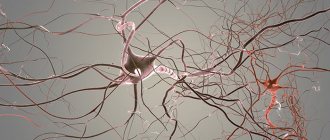Anxiety disorders
- These are neurosis-like mental states, the main symptom of which is a feeling of anxiety.
Such conditions differ from the usual fears and anxieties that can always be observed in children during their development. Feelings of fear, danger, anxiety are the most important adaptive signals in the psyche of every person and accompany us throughout our lives. But in certain cases, the mechanisms that regulate the intensity and duration of anxiety fail and then the normal course of psycho-emotional development is disrupted.
Anxiety disorders can be of several types depending on their manifestation:
Social anxiety disorder
- fears of meeting or communicating with people;
- avoidance of social situations;
- lack of friends outside the family
STORY
The girl Olya, 10 years old, was very often worried. Every morning she worried whether she would be late for school, although she always arrived at school on time. Every day she worried, did she put everything in her backpack? At night she worried about whether she had done her homework well and whether her clothes would look neat the next day?
Olya's parents thought this behavior was a typical part of growing up. Gradually, the girl began to study worse, was often in a depressed mood, and her relationships with her friends went wrong. Unable to influence their daughter, to change her attitude to what was happening, the parents decided that it was time to talk with a specialist about how to find a way to help Olya cope with her anxiety.
Symptoms of increased anxiety
“Sometimes it seems to me that there is no situation that she would not worry about. Literally everything worries her: darkness, thunderstorms, elevators, loud noises... She is still afraid to fall asleep alone - and she is already nine years old! For me this is nonsense. At her age, I was brave, I was already climbing into garages with all my might with the boys and saying that I was already an adult. And she is a very delicate flower. I’m already silent about strangers, and about acquaintances too. Teachers complain that the girl is capable, but she is so shy that she cannot answer in class, remains silent, and may even cry. At home she cries again and says that she will never succeed, that she is stupid, that she is the worst of all. He doesn’t want to do anything - neither sports, nor music, nor drawing. Afraid that it won't work out. Although he loves to read, he helps around the house, so it’s not a matter of laziness at all. I feel very sorry for her, I constantly talk, try to calm her down, never scold her, but nothing changes.”
Victoria, mother of 9-year-old Sasha
You can talk about increased anxiety if your child regularly displays the following signs:
- self-doubt, low self-esteem;
- fear of new things or people;
- refusal to perform work that involves difficulties;
- fears that do not correspond to age: if a child over seven years old is afraid to go to school, go outside, stay at home alone, fall asleep alone;
- sleep disturbances, nightmares;
- decreased appetite;
- “bad habits”: the child bites his nails, constantly twirls his hair around his finger, pulls out his hair, etc.;
- tearfulness, vulnerability;
- stiffness in a new environment;
- attacks of anger, irritability;
- many phobias.
Anxiety attacks are also accompanied by physiological manifestations: rapid heartbeat and breathing, dry mouth, trembling, digestive disorders and other signs - the symptoms are individual for each child. [2]
Causes of anxiety disorders
It is difficult to name the exact cause of such a disorder in a child, as well as in an adult. Experts name a number of provoking factors:
- Genetic predisposition.
Having an anxiety disorder in a parent increases the risk of similar symptoms in a child. - Stressful life circumstances.
Events in a child’s life can become a starting point (trigger) for anxiety disorders in childhood or adulthood: loss (death of a loved one or divorce of parents), life changes (moving to a new city, changing schools, going to kindergarten). Children who have experienced abuse are more likely to have anxiety disorders. - Upbringing
. Growing up in a home where other family members are constantly anxious can teach a child to view the world as a dangerous place. If a child grows up in a truly dangerous environment (domestic violence), he may experience excessive stress, fear and expect the worst.
Diagnosis and classification of TR
The first task that must be solved when diagnosing TD is to distinguish anxiety as a normal and proactive response to threatening or stressful influences from the manifestation of TD. Anxiety performs an adaptive signaling function (“signal alarm”) to prepare at the organism level to encounter danger and select a reaction to it: “attack, fight” or “escape, avoidance.” Normally, manifestations of anxiety are short-term (transient) in nature and are well under the control of the individual.
Manifestations of anxiety acquire clinical significance in cases where:
their severity and duration become significant;
symptoms occur in the absence of stress factors;
symptoms disrupt the physical (somatic) and socio-psychological functioning and adaptation of the individual.
The presence of TD is indicated by the fact that the child experiences anxiety more often (for example, on most days of the month and for several months) and experiences it more intensely compared to peers. Excessive anxiety leads to significant disruptions and limitations in a child's life: it is difficult for him to participate in normal activities for his age, attend school, cope with daily school and homework, socialize and make friends, and attend leisure activities and sports clubs. Table 1 presents the differences between anxiety and fears that are acceptable during the individual development of children and their pathological manifestations.
All forms of TR are accompanied by changes at four levels.
Emotions: fear, apprehension, embarrassment, shame, helplessness, guilt, sadness, anger.
Thoughts: about possible harm/danger/damage that cannot be dealt with on your own, negative thoughts of an obsessive nature.
Behavior: choice of avoidance strategy (active avoidance of specific situations, places or stimuli, its erased manifestations in the form of uncertainty, indecision, desire for loneliness) and the use of so-called “safety techniques” (recourse to objects and situations that do not allow the development of extremely pronounced fear, with the formation of “rituals”). There may be repeated appeals to adults for comfort and support, and excessive apologies to other people.
Sensations (physiological level): due to an imbalance of autonomic regulation - rapid heartbeat, rapid breathing, increased sweating, headache, dizziness, feeling of lack of air and approaching fainting, cramps and pain in the abdomen, nausea, vomiting, diarrhea, paresthesia (tingling, numbness) in the face or hands, a feeling of unsteadiness or weakness in the legs, a tendency to tremble or tremors, sleep disturbances (difficulty falling asleep, restless sleep, nightmares, insomnia).
One of the key signs of TD is fear, but it should not be equated with anxiety. Anxiety is a combination of emotions, and fear is one of the emotions. Fear, as a normal emotion, is a reaction to an external threat and is adaptive in nature; it warns the individual that the situation may be physically or psychologically dangerous. Fears are characterized by normal age-related evolution (Table 2). Moreover, they can be of a realistic nature (in relation to specific animals, bodily injuries, natural phenomena) and unrealistic, irrational (fear of the dark, mice, monsters, disasters).
Thus, fears as an isolated phenomenon should not be considered as a sign of illness. The help of a specialist is necessary in cases where fears lead to obvious social restrictions: refusal to go outside for fear of meeting a dog or experiencing a panic attack, refusal to attend school.
In the clinical picture of TD, fears are characterized by a stable and non-adaptive nature [9]:
excessive intensity that does not correspond to the situation (quantitative aspect);
unusual content and unusualness of objects that cause fear (qualitative aspect);
inadequate response to the situation;
chronic fear;
inability to reduce or overcome fear;
significant restrictions in everyday life.
Ultimately, manifestations of TD affect all areas of life, significantly worsening the child’s general well-being, school performance, family relationships and friendly contacts, and social activity.
TR include [1, 2]:
TD associated with separation in childhood (separation TD);
selective mutism;
phobic TD of childhood (specific phobias);
social TD of childhood;
generalized TR of childhood;
panic disorder;
agoraphobia.
Two other disorders that were previously classified as TD are obsessive-compulsive disorder and post-traumatic stress disorder. In modern classifications [1, 2], they are considered as separate nosological forms.
Separation TR
Some children experience fear and painful apprehension because, with a real or imagined threat of separation, something bad will happen to them or their loved ones (most often to their parents). The child strives to avoid separation, experiences excessive fear, sadness, and withdraws into himself. On the other hand, there are attacks of rage, crying with the desire to keep a loved one nearby, clinging to him and a categorical refusal to part. The child refuses to be in situations where he may find himself without loved ones: staying away from home at night, visiting friends or relatives, being at home alone, or going to school without parents. After suffering separation from loved ones, children remain depressed, withdrawn and apathetic. They refuse to be alone in the room and ask parents to be present or available.
Separation anxiety usually goes away as children grow up, go to school, and gain confidence. However, for some children, their reaction to actual or expected separation continues to be excessive, which can sometimes continue into the first 1–2 years of school and even beyond. Manifestations of separation anxiety disorder can impede or limit the child’s normal activity, lead to deterioration in school attendance and academic performance, and isolation from peers because he avoids participating in school outings, excursions, games, overnight trips without parents, or other activities. Such children differ from their peers in their lack of independence.
Separation-related TD is most common in children under 12 years of age and decreases in incidence during adolescence. This type of TD affects about 4% of children and 1.5% of adolescents [1, 3, 4]. However, separation anxiety can persist into adulthood.
The occurrence of separation TD reaches its peak in several age periods: upon entering kindergarten, in elementary school at the age of 7 to 9 years, upon entering middle and high school. Boys and girls suffer from separation TD equally often. During adolescence, separation anxiety either persists or arises for the first time (after a stressful event, such as parental divorce, loss of a loved one, moving to a new school, moving).
Selective mutism
Selective mutism —
one of the forms of TD in children, which in some cases has to be differentiated with alalia (developmental dysphasia). Manifests at the age of 2–5 years. The prevalence in the pediatric population is less than 1% [1, 10]. More often, selective mutism occurs in families with bilingualism, when moving to a new place of residence with a different language environment. It occurs during the period of active speech development or upon entering kindergarten, in preparation for school. Selective mutism limits communication capabilities, can distort the child’s mental development, and complicates his social adaptation.
The child stops talking to everyone except a small circle of familiar people. This continues for a long time, up to several months. Despite the preservation of speech, the child consciously refuses verbal communication (and sometimes any communication) in situations that are psychologically traumatic for him (both in a group of children and among adults). At the same time, he not only refuses to speak - he is unable to do so because of the feeling that his speech seems to freeze in the larynx. Gradually, the child learns to anticipate situations that provoke mutism and tries to avoid them.
An important feature is that the majority of patients with selective mutism have manifestations of social TD, and at an early age - separation TD [10]. A number of patients experience a combination of selective mutism with disorders such as speech development disorders, enuresis, encopresis, delayed motor development, autism, and in rare cases, attention deficit hyperactivity disorder. Selective mutism is not currently considered within the framework of oppositional behavior, but oppositional reactions may occur if the child is forced to speak.
Although the first symptoms of selective mutism appear before the age of 5, they may become most noticeable once school starts. Selective mutism causes significant difficulties in children's lives, affecting their academic performance, preventing them from seeking help from teachers and other adults, and preventing them from enjoying social interactions and participating in daily activities with their peers. In older children and adolescents, difficulties in communicating with peers often increase, which serves as a prerequisite for the formation of social and generalized TD or depression.
Specific phobias
Fears are common and expected in childhood, but for some children and adolescents, fears become intense over time and develop into phobias. A phobia is a strong fear that is disproportionate to a specific object or situation, extremely severe anxiety in the absence of immediate danger. Intense fear of certain situations and objects is accompanied by an avoidance response due to the belief that they are dangerous and will cause harm/injury. The most common pathological fears in children are caused by: animals (dogs and birds), insects and spiders, darkness, loud noises (especially those associated with natural phenomena), clowns, people in masks or unusual appearance, injections, diseases, the sight of blood.
Specific phobias manifest from early age to 10 years; they affect 6–9% of children and adolescents, more often girls than boys (in a ratio of 2:1) [1, 3, 4].
Some patients develop a phobia after exposure to a traumatic or frightening event, while others develop fears after observing other people's anxious reactions. Thus, a younger brother often begins to be afraid of a spider if he witnesses how the older brother runs away from the spider in fear and screaming. Phobias are different from ordinary childhood fears and rarely go away on their own. Often, phobias do not decrease, despite explanations and assurances of safety from adults. As a result, the child avoids frightening places or objects, forces parents to check if they are nearby (for example, before going to bed he wants to make sure that there are no spiders in the room), requires parents to stay nearby.
Children avoid parks, playgrounds, recreation areas and other places where there may be insects, refuse walks and nature excursions if they may encounter what they consider dangerous animals (for example, dogs), and protest against visiting medical institutions or doctors. , in particular dentists. As children grow older, phobias do not disappear, but change in content. But teenagers are more likely than younger children to recognize that their fear is disproportionate to the actual danger posed by a particular object or situation. In addition, unlike young children, who have less control over themselves in everyday life, adolescents can independently avoid certain situations and direct confrontations with their fears.
School-age children may experience a fear of school, which manifests itself in the same way as a phobia, and they refuse to attend. In this regard, the term “school phobia” appeared, although as such there is no diagnosis or form of TD with this name. The range of manifestations of school fears can vary from minor complaints about the need to attend classes to hysterics and refusal to go to school in young children, and in adolescents - to frequent absences from classes with subsequent exclusion from school. Children may be afraid of school for many reasons, for example, because they have to be left without parents (as happens with separation anxiety disorder), because of fear of contact with germs (with obsessive-compulsive disorder), because of fear of interactions with peers and teachers (with social TD). In these cases, the child or teenager is actually afraid not of the school itself, but of the events that could happen to them there. Because of this, the term “school phobia” is not accurate.
On the other hand, the causes of school phobia may be difficulties in adapting to the classroom, fear of bad grades, fear of making a mistake or getting reprimanded by the teacher, conflicts with classmates, fear of physical aggression on their part. Some parents, without noticing it themselves, instill in their children a fear of school by overly dramatizing learning problems; they deprive the child of the opportunity to show initiative and independence - they do homework for him or strictly control them, resenting every clumsily written letter. As a result, the child is not so much afraid of school as he is afraid of not meeting the high expectations of his parents. Any of these problems can make a child's school life unbearable. In such cases, not only parents, but also teachers should help him cope with this situation.
Social TR
Social TD manifests itself as intense, accompanied by an avoidance reaction, fear of situations related to social contacts, any forms of behavior in public places, when the child/adolescent thinks that he will do something wrong and will cause a negative assessment and ridicule from others. Such situations include public speaking, answering lessons in front of the class, taking exams, meeting new peers, parties, playing sports, conversations with elders or leaders, including teachers at school, when the child is the center of attention. Some children are only afraid of speaking or performing in public, while others are afraid and avoid a wider range of social situations.
Social TD is observed in 2–7% of children and adolescents, equally often in boys and girls, manifests itself at 7–13 years of age, more often in early adolescence, but can also manifest itself in elementary school [1, 3, 4]. Social TD appears suddenly after suffering stress or develops gradually over time.
Problems associated with social TD: passivity in class (cannot ask questions and answer clearly, read aloud, write on the board, express and defend opinions), poor academic performance, low self-esteem and uncertainty in social situations, difficulties in establishing and maintaining friendships, refusal to go to group events (birthdays, parties). The child cannot eat in the presence of others or use a public toilet. Children become overly shy and often expect things to go wrong when they are surrounded by other children. However, they may be concerned that others are watching them and discussing their behavior.
Social TD goes unnoticed by teachers and parents for a long time, because such children do not want to remain in the public eye and try to be invisible. Therefore, they are only noticed when they start skipping school or getting bad grades.
Adolescents and young adults with social TD are even more self-focused and have low self-esteem. When they start working, due to extreme fear or embarrassment, they may feel awkward when making acquaintances, interacting with colleagues, or interviewing management. They have an increased risk of depression, alcohol or drug use.
Generalized TR
Generalized TD is manifested by excessive anxiety with anticipation of an unfavorable development of a variety of events and circumstances related to the family, the state of one’s own health and those of loved ones, financial situation, friends, school, as well as everyday affairs. A child in such a situation is characterized by a constant search for support from parents and other people in connection with his own fears, avoidance of everything new, especially negative news, uncertain situations, and the possibility of making a mistake. It is also typical to have somatic symptoms, insomnia, irritability, muscle tension, and difficulty concentrating during anxiety.
The manifestation of generalized TD occurs at the age of 10–12 years, it is observed in approximately 1% of adolescents, 2 times more often among girls than among boys [1, 3, 4]. If left untreated, the disease does not disappear until adulthood and leads to a significant deterioration in quality of life.
Patients with generalized TD experience persistent irrational and uncontrollable worry about various aspects of daily life and future events, including minor issues. Young children tend to worry about simple and immediate issues, such as family safety, love and affection from loved ones, and school success. Adolescents show concerns about the health and safety of themselves and their families, academic performance, friendships and relationships with other people, their own punctuality, their future, relationships between parents or family stability, world events (related to nature, climate, environment). environment, politics, crime), etc.
Since patients with generalized TD experience severe somatic symptoms of anxiety, fatigue, irritability, impaired concentration, muscle tension and sleep disturbances, exaggerated, physically debilitating constant and uncontrollable anxiety, this has an extremely negative impact on the quality of life of the child and his family. The behavior of a child in this state is characterized by excessive time spent on completing homework, repeated tedious thinking about situations, repeated and unreasonable compilation of lists, frequent checks (of the progress of current affairs, relationships, health status with the identification of possible illnesses), procrastination in completing tasks, painful focusing of interests on subject of concern. This creates a tense environment around the child, worsens friendships and family relationships due to constant fears and endless requests for support.
The negative impact of ongoing constant worry becomes more obvious the older the child gets. Parents, teachers, and other adults notice that the teenager is different from his peers, spends a lot of time doing tasks ineffectively, appears stressed and exhausted, and refuses to participate in recreational activities or spend time with friends out of fear of failure. Over time, constant anxiety and detachment from friends and common activities with them increase the feeling of one’s own inferiority and predispose to depression.
Panic disorder, agoraphobia
Panic disorder - repeated and developing unexpectedly, without connection with any reason or situation, attacks of extreme anxiety (panic), which quickly reach a peak, are accompanied by threatening, in the patient's opinion, somatic symptoms (chill-like trembling, shortness of breath, palpitations, pain or discomfort in the chest, dizziness, nausea, profuse sweating, numbness, paresthesia, feeling of powerlessness), fear of death or madness. A panic attack is a sudden outburst of intense fear and discomfort that peaks and subsides within a few minutes. Following a panic attack for at least one month, the patient experiences anxiety about the occurrence of new attacks, he is afraid that something irreparable will happen to him due to a panic attack (losing control of himself, going crazy, dying), changing his behavior, to avoid a repeat panic attack (for example, avoiding physical activity).
In addition to panic disorder, many children and adolescents may develop agoraphobia, although the two conditions can exist independently of each other. Agoraphobia is characterized by intense anxiety and fear of real or perceived situations that may trigger a panic attack, and avoidance of such situations. Children are frightened by being in places from which it is difficult to get out quickly: public transport, open spaces (markets, bridges, parking lots), closed spaces (shops, cinemas, theatres), queues or crowds of people, they are afraid of being alone outside the home. Fear is associated with places from which it is difficult to escape and where it is impossible to get quick help. Therefore, children avoid as much as possible places and situations in which panic attacks have previously occurred; indoors they try to take seats near the aisle or closer to the exit; they try to maintain contact with security staff; they carry medications with them; they wear loose clothing that does not restrict movement; and they avoid physical abuse. exercise, any activity that activates the body.
Most often, panic disorder and agoraphobia manifest in young adulthood, but sometimes at 13–15 years of age. They affect approximately 2% of adolescents, girls are 2 times more likely than boys [1, 3, 4].
Problems associated with panic disorder and agoraphobia include low self-esteem, decreased independence, poor performance and absenteeism at school, refusal to travel and travel, difficulties in relationships with peers and family members, fear of separation from parents, transitions from home to school, disorders sleep, risk of depression and alcohol or drug use.
Pathogenetic mechanisms of TR
Previously, the term “childhood neurosis” was used in relation to TD. However, this concept is not entirely correct, since it means that the child’s emotional difficulties stem from unconscious internal psychological conflicts [7]. According to modern concepts, the development of TD occurs through the interaction of biological, psychological and environmental factors [8]. Risk factors include parental anxiety, child temperament with a tendency to withdraw, traumatic/negative/stressful life events, and parenting style [8].
Since various childhood TDs often occur in familial cases, much attention is paid to the study of hereditary predisposition and genetic mechanisms of TD. Neurobiological mechanisms (heredity and early brain damage caused by perinatal pathology) can lead to dysfunction of a number of brain structures and neurotransmitter systems [4]. The GABAergic, noradrenergic and serotonergic systems are considered key in the pathophysiology of TR and the mechanisms of action of anxiolytic drugs. It is assumed that further study of the neurobiological mechanisms of TD, including the use of functional neuroimaging methods, will make it possible to clarify the fundamental mechanisms of anxiety, the role of dysfunction of various brain regions, and to substantiate rational approaches to the treatment of TD.
When assessing environmental factors, it should be taken into account that to ensure the vital functions of a child’s body, many nutrients are needed, among which vitamins, macro- and microelements play an important role. Increased anxiety, irritability, emotional lability and fatigue can signal the body about metabolic disorders due to a deficiency of vitamins (especially group B) and minerals (in particular, magnesium, zinc). It is known that an increased need for vitamins and minerals at the usual level of their intake occurs in children during periods of the most intensive growth, under the influence of significant physical or psycho-emotional stress, and various stressful situations. The need for these nutrients also increases significantly in children with TD. A deficiency of vitamins, macro- and microelements in the body can be associated not only with high costs, but also with their low content in consumed food products and water. Therefore, in the process of examining patients with TR, attention should be paid to the completeness of their nutrition, which is determined not only by the energy value of food and the balance of the diet in proteins, fats and carbohydrates, but also by the provision of vitamins, macro- and microelements.
Helping an anxious child
Anxiety disorders in children are dealt with by mental health specialists: psychologists, psychotherapists, psychiatrists. The specialist analyzes the symptoms, diagnoses a specific anxiety disorder, and outlines a plan to help the child.
Through work with a psychologist, children learn to think and act differently in situations that may cause anxiety, as well as cope with stress. The specialist provides support and guidance. Sometimes drug treatment is necessary.
Increased anxiety in a child: what to do
If your child suffers from increased anxiety, treatment should begin as soon as possible. Otherwise, this personality trait will most likely remain with him for life. As an adult, it will be more difficult to cope with it. We offer several ways to help your child overcome anxiety and increase his resistance to stress. These same tips can also be used to prevent anxiety disorder if your child is prone to it.
Learn to control your anxiety
Let us repeat again: children are most influenced by the behavior of their parents. Therefore, you need to start working with anxious children by defeating your own anxieties. If children see that adults are calm, trust the world and are not afraid to meet it halfway, they themselves will naturally become bolder and calmer.
Rethink your parenting style
Before treating your child for anxiety, think about whether you are asking too much of him in life. Maybe we should reduce his workload. For example, allow him not to go to a circle that he doesn’t like. And, of course, you cannot scold children for mistakes and failures, otherwise fear will constrain them before any new endeavor. Help your child cope with a difficult situation for him, show that you can be trusted. Remember: if a child perceives you as a source of danger and punishment, he will constantly feel fear and loneliness.
Teach your child to cope with difficulties independently
Do not rush to help the child until he asks for it, do not try to protect him from all difficulties. Let him know that you are there and will always help if necessary, but believe that he can handle it on his own. This way, the child will definitely believe in himself and will not give in to the slightest difficulties. And, of course, do not criticize for failures: it is better to praise for courage and independence and invite them to think together about how to correct the mistake. This will instill responsibility and stress resistance in the child.
It is also useful to have a pet - for example, fish, a turtle or aquarium snails - and entrust your child with some responsibilities for caring for it. The child will feel big and strong compared to his pet, this will strengthen his self-confidence and sense of self-worth.
Love your child for who he is
This means that you need to accept not only your child’s strengths, but also what you consider shortcomings - most likely, these are not shortcomings at all, but personality traits that make him different from others. Never compare your child with other children, praise him more often and tell him that you love him in any situation. A safe and comfortable environment at home, good relationships with parents reduce anxiety and increase stress resistance in children.
How parents can help
- The best way to help your child is to acknowledge the problem and provide support without criticism. Try to observe more carefully what causes difficulties for your child in everyday life and how he reacts to them.
- Contact a specialist to assess the child's condition.
- Be patient and positive if psychotherapy . In the process, the child will learn new ways of coping with anxiety.
- Sometimes it helps to talk to your child about your own stresses and how you were able to overcome them.
- Rest assured that with the right approach, your child will be able to overcome anxiety , learn to look into the future without unnecessary stress, and realize their full potential.
Test: your child's anxiety level
Sometimes it is difficult for parents to determine whether the child’s anxious state has exceeded acceptable standards. To answer this question, we offer the “Child’s Anxiety Level” questionnaire, based on observations. [1] Read the following statements and mark those with which you agree:
- A child cannot work for a long time without getting tired.
- He has difficulty concentrating on anything.
- Any task causes unnecessary anxiety.
- While performing tasks, he is very tense and constrained.
- Feels embarrassed more often than others.
- Often talks about tense situations.
- As a rule, blushes in unfamiliar surroundings.
- He complains that he has terrible dreams.
- His hands are usually cold and damp.
- He often has upset bowel movements.
- Sweats a lot when excited.
- Doesn't have a good appetite.
- Sleeps restlessly and has difficulty falling asleep.
- He is timid and fears many things.
- Usually restless and easily upset.
- Often cannot hold back tears.
- Doesn't tolerate waiting well.
- Doesn't like to take on new things.
- Not confident in myself, in my abilities.
- Afraid to face difficulties.
If the number of positives exceeds 15, your child most likely has an anxiety disorder. If you answered positively to 7 or more statements, your child is at risk. We advise you to pay attention to the problem and take measures to prevent and treat increased anxiety.
Exercises to reduce anxiety in children
Also, the recommendations of the French teacher M. Borba can help an anxious child. She offers several simple exercises that are aimed at relieving stress in children. They can be used in combination or separately. They turn anxiety management into a game, which improves performance. [2]
- Internal dialogue. Find a phrase with your child that will increase his self-confidence and teach him to say it in a stressful situation. For example: “I will succeed”, “I can handle this”, “There is no reason to worry.”
- Elevator breathing. Invite your child to close his eyes, exhale three times, and then imagine that he is going down in an elevator from the top floor to the first. Once the elevator reaches its destination, the excitement will disappear. You can also use any other breathing exercises to combat anxiety.
- Melting away stress. Ask your child to find a place where tension accumulates. Usually this is the neck, shoulders, jaws. You need to strongly tense this place, and then sharply relax it and feel how the clamp leaves the body.
- Visualization of a calm place. When a child is overcome by anxiety, he can imagine a place where he feels calm and happy. This helps because, firstly, the child is mentally transported to a safe environment, and secondly, in principle, he is distracted from restless thoughts.










